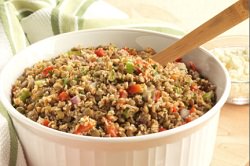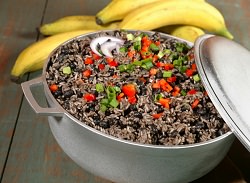In just the last few years, healthy eating and cooking have become much easier, thanks to the advent of "healthy" restaurant menus, the expansion of the health-foods aisle into entire sections, and the resurgence of farmers markets and backyard gardening--all due in large part to the demand from conscious consumers like you.
Old favorites like oatmeal are once again our breakfast of choice; once-foreign foods like Greek yogurt, flaxseed and pomegranates are familiar sights in supermarkets; and salads are no longer considered "rabbit food" but a chance to bulk up your meals with vegetables.
As 2011 draws to a close, our food and nutrition experts weighed in with their predictions for the future of food and what will be on their--and your--plate next year.
These trends are a collaboration among:
Let food be thy medicine:Diabetes affects one in eight Americans (source); heart disease is the leading cause of death in the U.S. (source). We're hearing from our more than 11 million members that they're not ready to become a statistic. They're taking control of their health through exercise and nutrition.
That means taking the salt shaker off the table, eating at home more often to control what's going into their food, and making health-conscious choices whenever possible. In "The SparkPeople Cookbook: Love Your Food, Lose the Weight," we kept a close eye on sodium, and Chef Meg shared numerous tricks for tricking taste buds and cutting fat but keeping flavor.
If the popularity of SparkPeople's diabetes program is any indication, 2012 is set to be a year of major change for many Americans. They might have diabetes, but it doesn't have them.
Expect to see more people fighting for their health--starting at the dinner table.
Learn more:
 Bringing back family dinners:Chef Meg, Becky, and Tanya are all moms. They agree: The #1 thing you can do as a family to take control of your health is to eat dinner together. Turn off the TV, shut down the computer, and talk over a meal. It doesn't have to be fancy, and you can sometimes take some help from healthy takeout or prepared supermarket foods. You just have to eat together.
Not only is your family more likely to make better food choices if you're eating together, but you can actually lower the risk of your children being obese, doing drugs or smoking while increasing their chances of getting good grades, according to studies. (I learned this and more while researching the cookbook.)
Becky suggests starting with a goal of a few nights a week and moving from there--and remember that breakfast is another great time to eat together and catch up on one another's lives.
Expect a continued revival of family dinner as a special time to share not only a meal but also quality time together.
Learn more:
 Back to basics:Consumers have their eye on the bottom line, and they're focused on easy-to-use, simple and healthy ingredients. Chef Meg says more of us are heading to the bulk bins for staples like dried beans and whole grains, to cook up old favorites like bean soup, casseroles and hearty soups and stews.
We're not reaching for fancy exotic seasonings that are not very versatile but taking a second look at spice-rack stalwarts like dried thyme and oregano, which are great in a variety of dishes.
Expect to see consumers bypassing expensive prepackaged meals and pricey ingredients for bulk items that are a great value and foods that can be used in a variety of ways--not just in one dish. Meg also predicts that our newfound affinity for bulk bins will have us experimenting with various whole grains, which might seem "fancy" but are quite simple to prepare and affordable.
Learn more:

More healthy restaurant choices:Tanya has been writing about healthier restaurant options since 2008. She updates her entries often, and lately it seems there is always something new to add.
Members are constantly sharing their latest finds on our Dining Out Guide, too. While chain restaurants will never stop trying to one-up each other with salty, fatty, and downright outrageously unhealthy options, most of them have taken the hint that a growing number of consumers will eat healthier options if they're available. Tanya told me that sky-high sodium levels are still prevalent, but she is pleasantly surprised by the number of options available these days.
Expect to see more restaurants expanding the healthy sections of their menus in the coming year.
Learn more:

DIY from seed to table:While restaurants are taking a step in the right direction, consumers are getting the message that they need to start taking matters into their own hands--cooking and even growing their food themselves. The "eat local" and "farm-to-table" movements are encouraging us to get to know not only who's growing our food but what's in it. And we're liking it!
Whether it's community gardening or cooking dinner as a family, doing it yourself is a great way to turn food into an experience and spend time with those around you. Becky sees schools, hospitals and even businesses appreciating the value of growing at least some of their own food--whether it's a restaurant with a windowbox for herbs, a rooftop veggie garden at a community center, or some containers in a classroom, it's all making a positive difference in our lives.
Meg is teaching people to use parts of food that you would usually discard--encouraging them to use fennels fronds as garnish, eat the sweet potato skins, and save the celery leaves for making stock. If 2011 was the year of snout-to-tail cooking, Meg says, 2012 will be the year of stem-to-root cooking--and keeping veggies out of garbage cans!
Expect farmers to be the new rock stars, says Meg. Just as we pulled chefs out of the kitchen and into the spotlight to answer our cooking questions, so too will we do with farmers. We'll be asking how it was grown, what to do with it--and much more!
Learn more:

Comfort food done right:While our members and experts love a good salad as much as the next healthy eater, we all agree: comfort foods can and should be a part of our meal plan! Becky said this is something she hears time and again on the SparkPeople Message Boards. Meg and I kept this in mind while writing "The SparkPeople Cookbook," and the subtitle, "Love Your Food, Lose the Weight" explains our commitment to flavor.
We're often asked what separates SparkPeople from other weight-loss and healthy-living websites. For starters, we don’t use the "d" word. Diets aren't sustainable, especially if they exclude certain foods or entire food groups. For us (and in the cookbook), no food is off-limits--and that includes butter, bacon and chocolate. When you use ingredients in moderate portions and know how to maximize their impact, there's no need to ever exclude a food again. Comfort foods are back on the table--from macaroni and cheese to sloppy Joes, tuna noodle casserole to spaghetti with meatballs, Chef Meg has made them all. (Psst… those recipes are in "The SparkPeople Cookbook"!)
Expect to see more makeovers of your favorite comfort foods from Chef Meg. Keep those suggestions coming!
Learn more:
 Mainstream meatless meals:More of us are skipping meat for at least some meals, and that number is continuing to grow. Vegetarian chili was the #1 most-tracked recipe by SparkPeople members this year, and seven of the top 10 recipes are meatless as well. Rather than label themselves, our members are seeking our meatless meals as a way to save money and improve their health.
Even if they aren't cutting meat out of a meal, members are starting to change the layout of their typical dinner plate. The meat is becoming less of the focus of the meal, and as the new MyPlate recommends, it takes up just 1/4 of the plate--and 1/2 of that valuable real estate goes to fruits and vegetables.
Expect to see more people skipping meat and filling their plates with fiber-rich beans and lentils (two of Chef Meg's "hot" foods for 2012).
Learn more:
No matter what steps you take to improve your health in 2012, we hope that it's your healthiest, happiest year yet. We firmly believe that, with nutrition as well as fitness, small steps can add up to really amazing, long-lasting goals. Whether you're just learning how to cook, want to make over your existing recipes, or need to break a fast-food habit, these trends and predictions can help you take a first step.
What do you think about these food and cooking trends and predictions? What do you expect (or hope) to see more of in 2012?
|
|





















